The island known in Mandarin as Lán Yǔ (蘭嶼 / 兰屿) has a lot of different names, including Orchid Island, Ponso no Tao, Pongso no Tawo, Irala, Tabako Shima, Tabaco Xima, Botol, Buturu, Kotosho, and Botel Tobago.
In texts in the roman alphabet, most of the time it’s referred to as “Lanyu.” That’s how I’ve written it in the past. But the Xinhua Pinxie Cidian (p. 21) gives such island names with the yu separate, so I’m going with the Pinyin standard from now on.
Anyway, there are plenty of names for this beautiful place off the southeast coast of Taiwan. But it doesn’t have much in the way of official signs. In large part, that’s because it doesn’t really need many, given the fact that the entire island has only a couple of roads: a ring around the island and another cutting over the mountains, plus a few minor side roads, some not much larger than a sidewalk. It’s not overrun with tourists; and the inhabitants certainly don’t need any signs to tell them where they are or to keep them from getting lost.
Click on any photo for a larger version.
Someone there told me that a long time ago the government assigned some roads the usual crop of Sino-centric names so beloved by the KMT: Zhongshan (i.e., Sun Yat-sen), Zhongzheng (i.e., Chiang Kai-shek), etc. But none of the Yami (Tao) people on the island were in the least bit interested in going along with that and ignored or even removed such signs. (Cars without license plates are also a common site there.)
In one village I found an official sign (but not one for a road) that had been appropriated for part of a wall on someone’s house or shed. This would, of course, have made for a great photo; but circumstances were such that I probably couldn’t have taken the shot without seeming disrespectful, so I passed the opportunity by.
I saw no trace of any official street signs. And even unofficial street signs were few and far between. (See the signpost image near the bottom.)
“Yehyu” and “Hungtou” are both in Wade-Giles. These would be Yēyóu Cūn and Hóngtóu Cūn in Hanyu Pinyin (and Tongyong Pinyin and MPS2 — though with the tone marks indicated differently) — for the Mandarin version of the name.
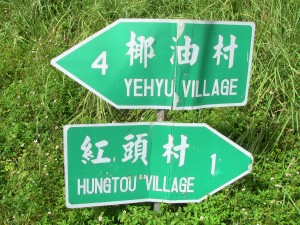
But Yayo appears to be the Yami name.
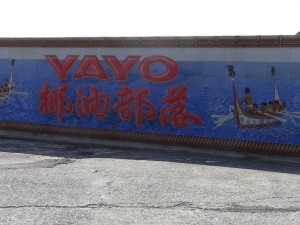
The sort of marker shown below is fairly standard. Note that the name in roman letters (Ivalino) is not a romanization of the Mandarin form (Yěyín Bùluò / 野銀部落). Note also the backward N, which is a mistake, not a special letter.
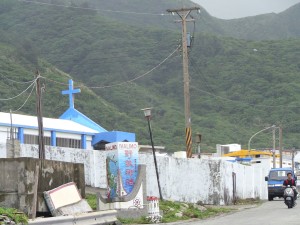
This photo perhaps best captures the nature of signage on Lan Yu — when there is any signage to be seen, that is.
I was saddened when I was there to hear children speaking only Mandarin with each other rather than the Yami language. But perhaps those I heard weren’t a representative sample.

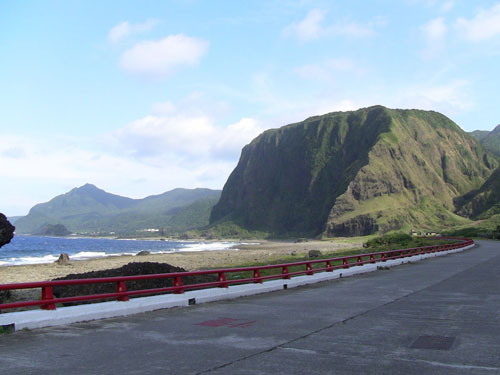

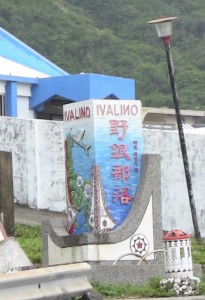
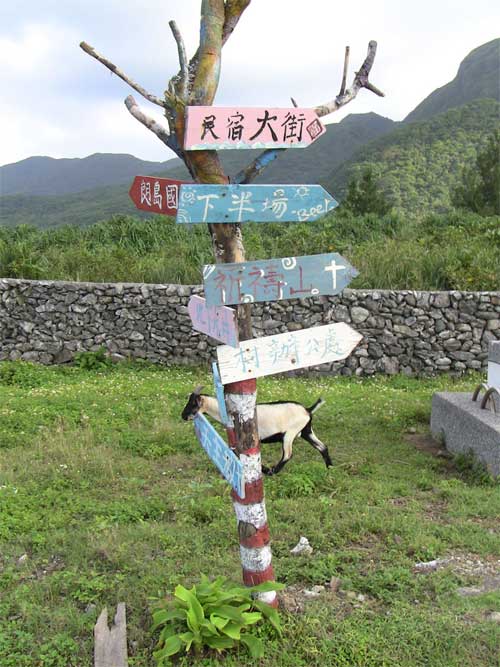

Unless I’m missing something, HPY c?n would be tsuen in MPS2.
Yes, that’s right. I was referring to “Yeyou” and “Hongtou” by themselves and should have left out the cun, which in Taiwan gets translated into English if it appears in the romanized version at all.
“Lan Yu” is also the more logical name because the actual name of the island is Lan as in Orchid, “yu” itself just means island or isle. So you wouldn’t write it as “Lanyu” any more than you would write “Caymanislands”. :)
BTW, how did you get to Lan Yu? About how much did it cost? Any recommendations for places to stay and/or transportation? I have been planning a trip there for a while now so any information you can provide would be appreciated :)
@Weili: The thing that makes me a bit uncomfortable about having “yu” separate is that it’s a bound morpheme (I believe). (I wonder why they didn’t go for “d?o” instead of “y?.”) But, well, the name is what it is, so méiy?u bànf?.
Now about the trip. I don’t recall the exact figures, so many of those below will be approximate. My wife and I took a somewhat roundabout way of getting there: riding the high-speed rail to Gaoxiong, and transferring to a regular train to Taidong (via J?nlún). Then the regular train again from Jinlun to Taidong (very cheap) and a taxi from the train station to the airport (NT$200?).
The plane to Lan Yu is small, holding only about 20 people. It looks a bit like a mini bus with wings. And the winds of Lan Yu made for a dramatic landing. I think the airfare was about NT$1600 each way. There’s a boat that’s considerably cheaper but is reportedly a pretty awful experience if you are at all inclined to seasickness. (And even if you’re not, it’s a pretty safe bet some of your fellow passengers will be. Eww.)
Scooter rental on Lan Yu was NT$400 per day. The scooter-rental guy will take your bags to your place for you, so you don’t have to balance everything on the scooter. There’s just *one* gas station, so don’t forget to fill up there when you pass by, if necessary.
We stayed in Ivalino in a place right next to the old-style homes. That cost NT$1,300 per night. The first night was in a little room with an uncomfortable bed and ants. We switched the next night to a tatami-style room with walls painted in a style somewhere in the intersection of zebra stripes, a lava lamp, and a Rorschach test. It was pretty comfortable. The room in the front corner, which we tried the third night, was even better. (It was easy to switch because no one was there the second or third night — and that includes the laoban, who was in Taibei).
It’s best to keep in mind that accommodations on Lan Yu are for the most part quite basic. But I liked it there a lot.
Many villages had *no* restaurants. So be prepared to eat a lot of pàomiàn, etc., if you go during the off season as we did. I had been expecting at least a great seafood or mutton barbecue; but to my surprise almost all of the food was from the island of Taiwan. Those goats and pigs wandering around everywhere are mainly for special occasions.
Interestingly, several people referred to the season — this was early October, mind you — as “d?ngti?n” (winter). It wasn’t cold, though, just a bit windy. Sometimes it seemed as if we had the whole island to ourselves (the first photo above is representative), which was just fine with me.
Paid accommodation is out of style.
http://www.couchsurfing.org/
http://www.couchsurfing.org/people/jidanni
I didn’t check if Lan Yu had couches though.
That would do for me. My wife, on the other hand, can be a bit picky about accommodations. Fortunately, she found the pigs, goats, chickens, etc. that roamed the streets to be ke’ai.
Speaking of place names, I have noticed here in Hong Kong, names have conspicuously separated after 1997. We used to have Wanchai, Shatin and Taipo, now they have become Wan Chai, Sha Tin, and Tai Po. What irks me is there are names which are never separated: Kowloon, Lantao, Lamma and Fanling. Don’t ask me why.
But in China and Taiwan, place names are mostly combined. Henceforth, as the name of a place, it should be Lanyu.